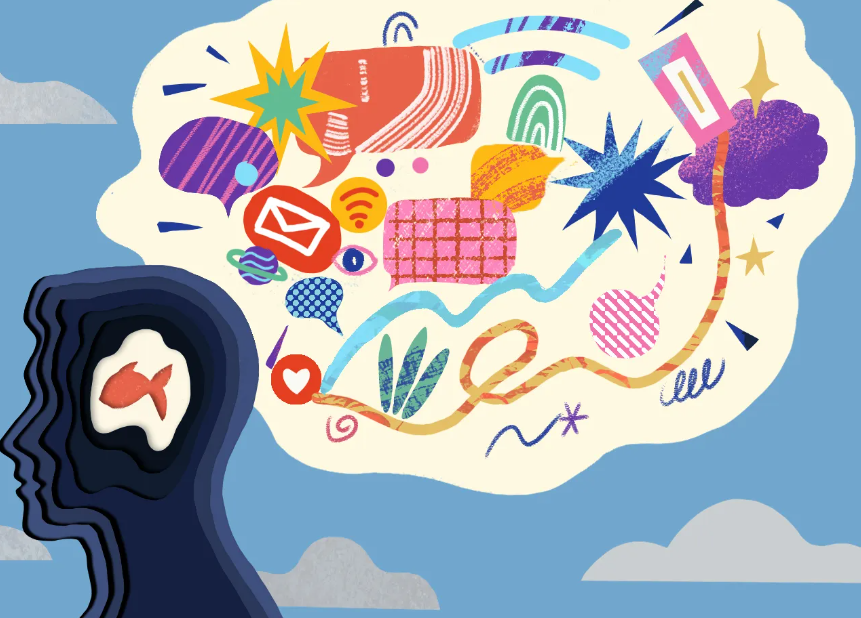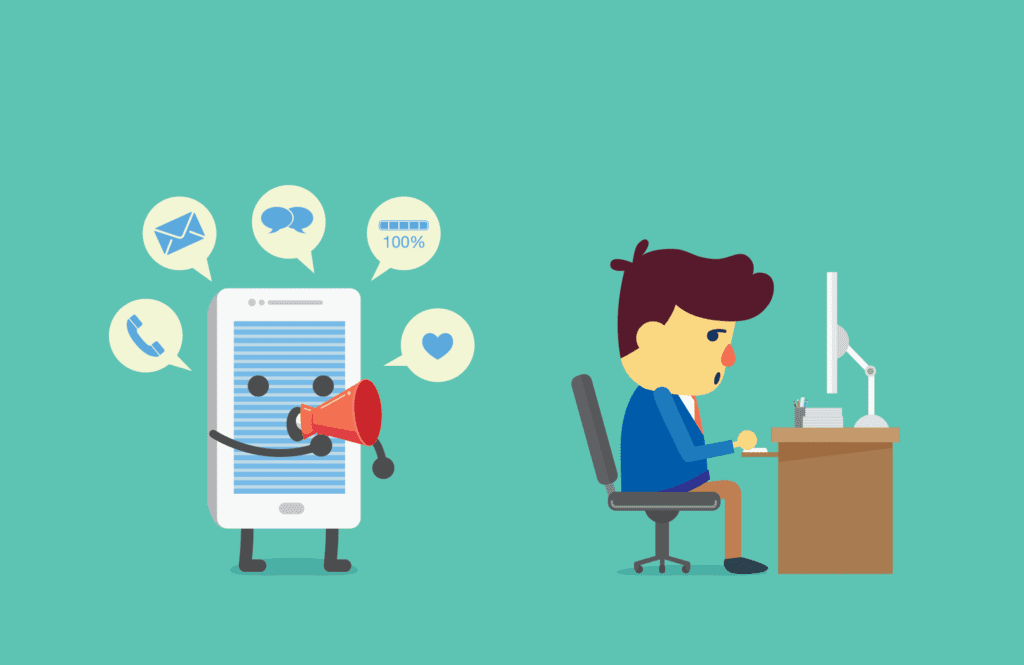
In today’s fast-paced and technology-driven world, our attention spans are shrinking. With never-ending distractions, it can be a real challenge to stay focused. The good news is that there are strategies you can implement to combat the negative effects of a shortened attention span and reclaim your focus and productivity. These techniques will help you stay focused and unlock your full potential, ultimately allowing you to live a more fulfilling and purposeful life. (Estimated reading time: 12 minutes)
“The time that leads to mastery is dependent on the intensity of our focus.”
– Robert Greene
As a child of the ’90s, I grew up in a generation that saw the world transform before our very eyes. We may be the last cohort to see life before mobile phones, computers, and social media.
I remember playing outside with my friends, reveling in games like hide-and-seek and climbing trees. The TV was restricted to two channels, where we watched shows like The Fresh Prince of Bel-Air and Teenage Mutant Ninja Turtles. We also played board games like Clue and Monopoly. Some of us played video games on a console, like a Nintendo or a Sega Mega Drive. Whatever we were doing, we were fully immersed in it.
’90s kids got the best of both worlds: the charm and wholesomeness of an existence unfettered by a tech-driven culture and the swift profusion of information after the explosion of technology in the late ’90s and early ’00s.
That’s why I believe my generation found it easier to adapt to and normalize the use of emerging technology. Our thoughts remained relatively steady and not fragmented by its velocity.
Unfortunately, this is not the case with the generations that came after us, namely Gen Z and Gen Alpha, who are having a more challenging time coping with the endless sources of distraction: emails, texts, pings from social media, and streaming services for videos, music, and news.
A study by Jean Twenge, Ph.D., found that adolescents who spent the most time on social media and the least in face-to-face social interactions reported the most loneliness. Other studies show that the use of social media and other tech devices can increase anxiety and depression in younger users.
This phenomenon is also visually apparent. Just take a stroll outside, take public transport, or go to a restaurant, and you’ll see people fixated on their phones. It’s like people are physically there but not really present. In times like this, I wonder what we have done to ourselves.
Our focus and attention spans are among the most precious resources we have—without them, we lose time and opportunities to make big strides in our lives. Distraction is even a problem in the corporate world. A study showed that the typical manager is interrupted every eight minutes, workplace distractions and employees generally spend 28 percent of their time dealing with interruptions.
The cost of distraction is high when it comes to performance. Not only do distractions take away our time and energy, but they also take away two other abilities essential to success: traction and creative flow.
In his book, “Indistractable: How to Control Your Attention and Choose Your Life,” author Nir Eyal describes traction as any action that moves us towards what we really want, whether that be working on a project, getting enough exercise or sleep, meditating, or listening to music.
“Traction is any action you do with intent. It’s doing what you say you will do,” Eyal writes. Distraction is the opposite of traction because it prevents us from accomplishing what we intend to do with our time.
Even with our best efforts at focus, we find ourselves scrolling through social media or grabbing our phones when we hear a notification. It makes it almost impossible to avoid distractions.
While they may seem impossible to avoid, we have what it takes to become less susceptible to them. As we continue to navigate the challenges of our modern, technology-driven landscape, it is essential that we remain vigilant and proactive in protecting our attention spans. With attention and discernment, we can reclaim our time and focus.
How do our attention spans work?

Our attention spans are a captivating and complex phenomenon that have been extensively researched by cognitive psychology experts. At its core, attention span pertains to the duration an individual can concentrate on a specific task or stimulus before becoming distracted or losing focus.
The study of attention span is deeply rooted in how our brains process and respond to information. The prefrontal cortex, responsible for executive functions like decision-making, problem-solving, and attention, is vital in maintaining focus. This brain region filters out irrelevant information, enabling us to concentrate on the task at hand.
But attention involves more than just the prefrontal cortex. The limbic system, which handles emotional processing, also plays a crucial role. This system releases neurotransmitters like dopamine, which impacts our motivation and attention. Dopamine release, triggered by rewarding experiences like receiving a notification, creates feelings of pleasure and reinforces the associated behavior.
This reward system, driven by dopamine, can significantly affect our attention spans. Regular exposure to rewarding stimuli like social media notifications or instant online content gratification can condition our brains to seek these rewards, leading to increased distraction. Consequently, this can result in a shorter attention span and reduced ability to focus on less immediately rewarding, long-term tasks.
How technology impacts our attention spans
In today’s digital era, the influence of technology on our ability to concentrate has emerged as a major cause for concern. The widespread availability of smartphones, tablets, and various other digital gadgets has created a continuous flow of information and distraction, posing a growing challenge for individuals to sustain their focus and attention.
Technology has significantly influenced our attention spans, mainly through the use of social media and various online platforms. These platforms are designed to be highly engaging and addictive, incorporating endless scrolling, push notifications, and autoplay features that ensure our continuous involvement and diversion. This constant exposure can give rise to a concept called “attention residue,” where our focus is split between the current activity and the temptation to browse our gadgets, ultimately leading to reduced productivity and concentration.
Furthermore, the nature of digital content can decrease attention span. A lot of online content, like articles, videos, and social media posts, is created to be consumed quickly, with eye-catching headlines and visuals that prompt quick shifts between various pieces of content. This habit of “snacking” on information in small portions can make focusing on longer, more detailed content and tasks challenging.
The vast quantities of information accessible on the internet can also be daunting, giving rise to “information overload.” When inundated with a continuous flow of data and stimuli, our minds can become overwhelmed, making it difficult to concentrate and efficiently process the information. This can lead to a diminished capacity to retain information, as well as heightened feelings of stress and anxiety.
What are the negative effects of a shortened attention span?

A reduced attention span can have wide-ranging consequences, impacting our efficiency and psychological well-being. When our focus is constantly shifting, it becomes harder to finish tasks and reach our objectives. This can result in missed deadlines, subpar work quality, and heightened stress levels. These challenges can lead to feelings of disappointment and failure, worsening the situation.
Additionally, an inability to stay focused can significantly affect our mental health. Persistent distractions and a diminished attention span can contribute to feelings of stress, anxiety, and even burnout. When we struggle to immerse ourselves in our work fully, we may experience a sense of dissatisfaction and purposelessness, negatively impacting our overall mental wellness.
Furthermore, the consequences of having a reduced attention span extend beyond just our educational pursuits. Constantly shifting focus between various activities and distractions can hinder our brain’s abilities to create the essential neural connections needed for effective learning and memory retention. As a result, acquiring new skills, recalling vital information, and engaging in profound learning encounters can become significantly more difficult.
Understanding the impact of a shortened attention span on our personal and professional lives is crucial. By delving into the scientific explanations behind attention span and recognizing the influence of technology on it, we can devise effective strategies and methods to counteract adverse outcomes and restore our concentration and efficiency.
Strategies to improve focus and concentration
There are several strategies and techniques available to help you stay focused and concentrate, despite a decreasing attention span. Incorporating some of these practices will increase your attention span, allowing you to immerse yourself more deeply in tasks.
1. Use time management techniques.
One highly effective strategy to stay focused is to efficiently manage and prioritize your time. By outlining a clear daily plan, identifying crucial tasks, and dedicating specific time slots to focus on them, distractions can be minimized, and productivity can be increased.
By implementing these time management techniques, individuals can better prioritize their tasks, minimize interruptions, and optimize their productivity:
- Pomodoro technique: This powerful time management strategy involves working in focused 25-minute intervals, followed by short breaks. This method helps to train the brain to stay engaged and productive for short, manageable periods while also providing regular breaks to prevent mental fatigue. By breaking down tasks into smaller, more manageable chunks, we can avoid the temptation to multitask or get sidetracked by distractions.
- Time blocking: This involves allocating specific time slots for specific tasks or activities. By creating a structured schedule and sticking to it, we can minimize the impact of distractions and ensure that we devote dedicated attention to our most important priorities. This approach can benefit tasks that require deep focus, like writing, coding, or strategic planning.
- Prioritizing tasks and creating to-do lists: By identifying the most critical tasks and addressing them first, we can ensure that our time and attention are directed towards the most important and impactful work. This can involve using techniques like the Eisenhower Matrix, which helps to categorize tasks based on their urgency and importance, or the “ABCDE” method, which assigns a letter grade to functions based on their priority.
● Take regular breaks and rest periods: By taking short breaks to stretch, grab a healthy snack, or engage in a brief mindfulness exercise, we can recharge our mental batteries and return to our tasks with renewed energy and focus. Additionally, ensuring we get enough sleep and maintain a healthy work-life balance can help mitigate the negative effects of a shrinking attention span.
2. Create a distraction-free work environment

In an age of constant digital distractions, creating a distraction-free work environment is essential to stay focused and improve productivity. We can train our brains to stay engaged and concentrated on the task at hand by minimizing potential distractions.
One of the most effective strategies for creating a distraction-free work environment is to limit access to digital devices and social media. This may involve turning off notifications, silencing phones, or removing devices from your work area. By reducing the temptation to check for updates or respond to messages, you can better maintain focus and avoid the cognitive burden of constantly shifting your attention.
Additionally, organizing and decluttering your physical workspace can create a more focused and productive environment. Keeping your work area clean, tidy, and free from visual clutter can minimize distractions and promote a sense of calm and focus. This may involve minimizing the number of personal items or decorations on display, keeping your desk clear of unnecessary items, and ensuring that your work area is well-lit and comfortable.
Incorporating elements of nature, like plants or natural lighting, can also positively impact focus and concentration. Research has shown that exposure to natural environments can help reduce stress, improve mood, and enhance cognitive function. By bringing a touch of nature into your work environment, you can create a more calming and restorative space that is conducive to focused work.
Finally, establishing clear boundaries and expectations around work time can also help to create a distraction-free environment. This may involve setting specific work hours, communicating with colleagues or family members about when you are available, and minimizing the interruptions and distractions arising from personal or social obligations. By establishing boundaries, you can better protect your focused work time and maintain your productivity and concentration.
3. Practice mindfulness.
In the face of the many distractions and challenges posed by our modern, technology-driven world, mindfulness practices can be a powerful tool to stay focused and enhance your attention span.
At its core, mindfulness is being fully present and engaged in the current moment without judgment or distraction. By training your mind to stay focused on the present, you can develop greater awareness, concentration, and the ability to ignore irrelevant stimuli.
Here are some techniques you can incorporate into your practice:
- Meditation: One of the most well-known mindfulness practices is meditation. Through regular meditation, you can learn to quiet your mind, reduce distracting thoughts, and cultivate a greater sense of focus and concentration.
- Body scan: In this exercise, you systematically focus your attention on different parts of the body, noticing sensations and physical experiences. By bringing your awareness to the present moment and your body’s physical sensations, you can train your mind to stay focused and present rather than being pulled into distractions or mind-wandering.
- Mindful breathing exercises: By focusing on your breath, you can anchor your attention and reduce the impact of external stimuli. This can involve techniques like deep breathing, where you take slow, deep breaths, or breath counting, where you count each inhalation and exhalation.
By training your mind to stay present and engaged, you can develop greater cognitive control, improved task completion, and a heightened ability to resist the temptation of distractions and stay focused.
4. Utilize technology to improve focus.
While technology has been widely cited as contributing to our shrinking attention spans, it can also be leveraged to improve focus and concentration. By strategically incorporating specific technological solutions, you can mitigate the negative impacts of digital distractions and enhance your productivity.
- Productivity apps and tools: These apps help block or limit access to distracting websites and applications. Apps like Freedom, Forest, or Focus Keeper can be programmed to restrict access to certain websites or apps during designated work periods, preventing users from succumbing to the temptation of social media, news feeds, or other online distractions.
- Task management and project planning tools: Apps like Trello, Asana, or Todoist can help individuals organize their tasks, prioritize their work, and stay on track with their goals. By providing a structured and visual representation of their to-do list, these tools can help users maintain focus, avoid task-switching, and ensure their time is effectively used.
- Productivity-enhancing hardware: Products like noise-canceling headphones or earbuds can help block out external distractions and create a more immersive, focused work environment. Similarly, standing desks or ergonomic chairs can help to improve posture and physical comfort, reducing the likelihood of restlessness or discomfort that can lead to a loss of focus.
By selectively and strategically incorporating technology-based solutions, you can harness the power of digital tools to enhance your focus, productivity, and overall cognitive performance rather than succumbing to the distractions that technology can sometimes present.
As we continue to navigate the challenges of the modern, technology-driven landscape, it’s essential that we remain vigilant and proactive in protecting our attention spans. Our attention is a precious resource that dictates what we can and can’t accomplish. It also determines how we feel at any given moment. Like a spotlight, our attention will direct our focus to those things that truly matter when it comes to our purposes and dreams.
All my best on your journey,
Seline

Questions for you: What is your biggest challenge when trying to stay focused in a distracted world? Were there any techniques that have helped so far?
Did you like this post? Sign up below, and I’ll send you more awesome posts like this every week.

Hi Seline.
As someone struggling with adult autism and ADHD, I understand this all too well. It is a struggle, and it never seems to get easier. Thank you for sharing this with us- it is nice to know people at least acknowledge this issue and are aware that it is something that is affecting many people.